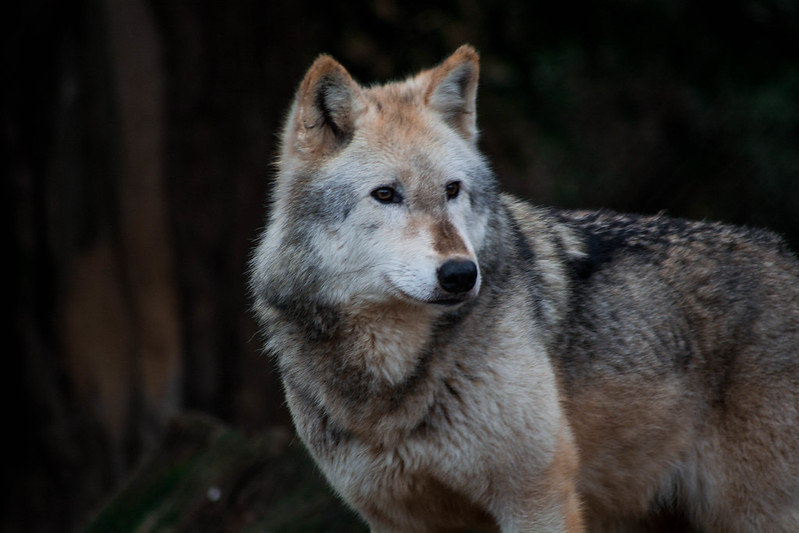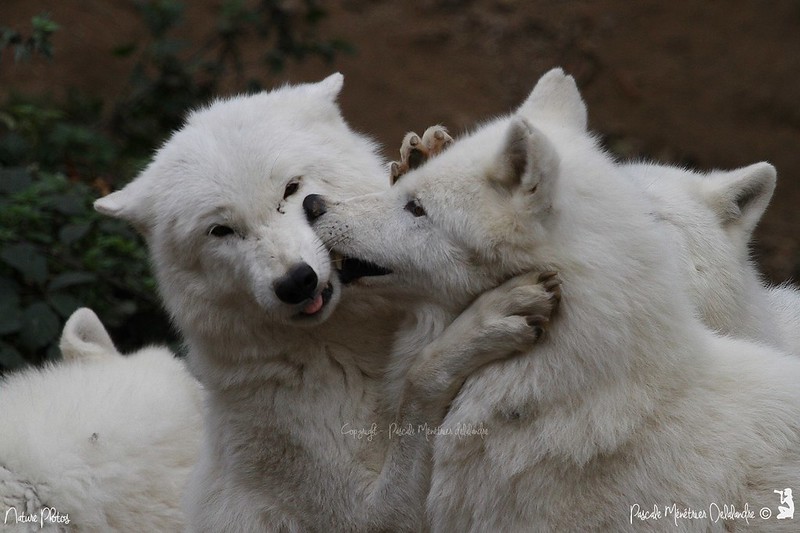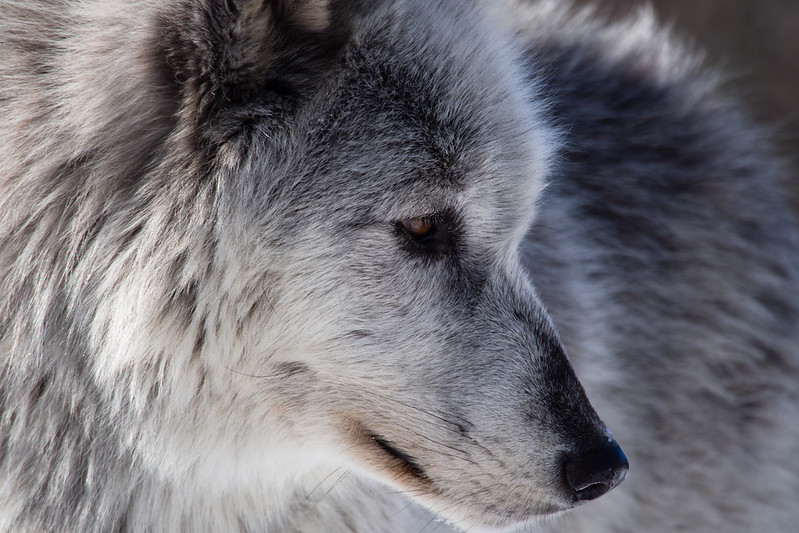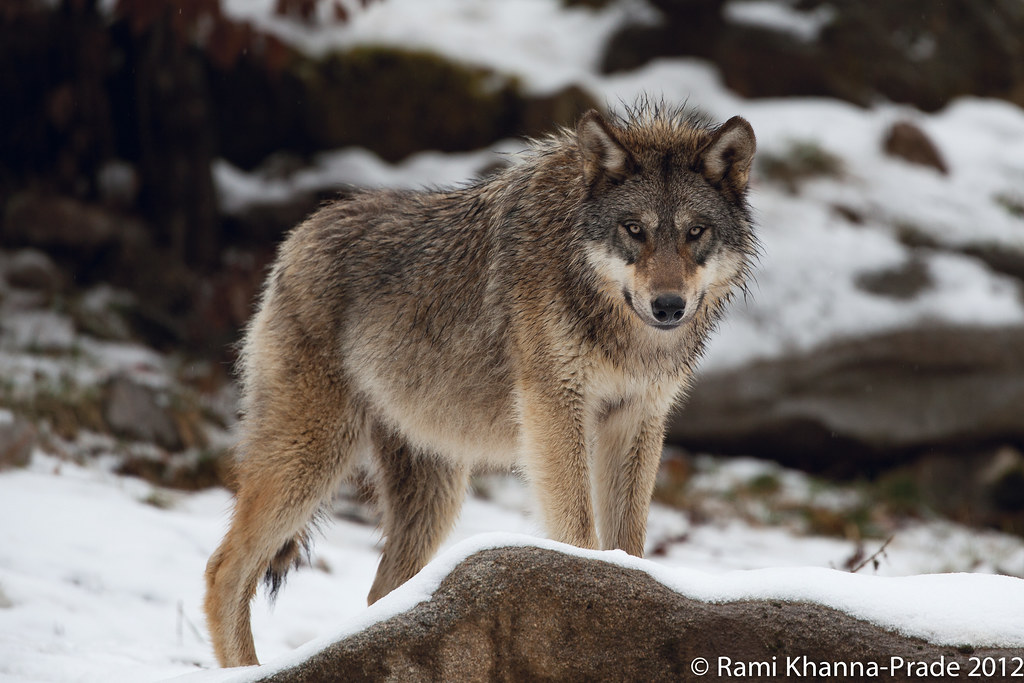Yamsi Ranch calving complicated by lone wolf on the perimeter
On a remote cattle ranch near the headwaters of the
Williamson River, a group of cows is separated from its herd.
Protectively, they huddle in a semicircle, nudging their calves to
safety behind them.
Cattle owner Joe
Jayne loads a shell in his shotgun as a black wolf circles the herd,
possibly sizing up the mothers and whether he should try for a calf.
Jayne pauses, holding up his shotgun to aim above the wolf, and fires a shell filled with an M-80 firecracker into the distance.
“I shot over him once, he turns around and
looks at us, and kind of trots off. He looks at us again, so I shot in
the air and he just kind of trots right through the calves,” Jayne said.
This
was the first time Jayne had seen wolf OR-25 at the 5,000-acre Yamsi
Ranch, a sprawling cattle ranch marked by miles of open pasture, stands
of mixed pine and surrounded by dense forest managed by the U.S. Forest
Service.
The 2.5-year-old male dispersed from the northeast Oregon
Imnaha Pack in March 2015 and arrived in Klamath County in May. He has
left the upper Williamson area several times, sometimes for weeks, to
roam the Klamath and Sycan marshes, traveling as far south as northern
California.
When Jayne fired the shells, OR-25 was standing only
about 60 yards away. Despite the deafening M-80 blast, Jayne said the
wolf appeared calm.
“He’s not scared of anything. He knows he’s
got a bulletproof vest on him,” he said, referring to protections given
to wolves by the Endangered Species Act.
GPS tracking helps, not fool-proof
Seated
at her dining room table, and looking through large windows, Jerri Hyde
points to a stand of trees little more than a quarter-mile from her
house. Jerri and her husband, John, are partners in the Yamsi Ranch’s
cow-calf operation, which breeds more than 400 cows each year.
Jerri
explains that OR-25 is fitted with a radio collar that intermittently
emits a GPS satellite signal and allows wildlife officials to track his
movements. Jerri said the ranch has a radio receiver that picks up
signals from a less sophisticated collar feature, a VHF (very high
frequency) signal that can be tracked from the ground. The signal placed
OR-25 in the trees when the cows were were pastured near there.
“He’s very bold,” Jerri said.
Since
OR-25 returned to the upper Williamson area a few weeks ago, Jayne,
John and Jerri have been scrambling to find ways to keep the wolf away
from the cattle and their newly born calves.
As of Wednesday,
about 15 calves had been born. Jerri said they are planning to birth
calves from each of the ranch’s 450 female cows.
What they did not plan on was keeping a 24-hour watch on the cows because of one very persistent wolf.
According
to Jerri, the standard barrage of non-lethal wolf deterrents have not
fazed OR-25. In addition to the M-80 shotgun shells, wildlife officials
have set up a noisemaker box, a strobe light and fladry fencing. The
specialty fencing consists of strips of fabric or colored flags draped
over a wire fence.
John Stephenson, a wolf coordinator for the
U.S. Fish and Wildlife Service, said the deterrents are the same that
are used to protect against wolf depredation in northeastern Oregon.
They have been successful on many ranches.
Jerri said OR-25 ran right through the fladry at Yamsi.
“Nothing is working,” she said with resignation. “Sometimes I wonder if he’s deaf.”
Trading shifts 24/7
OR-25
occasionally makes daytime appearances, but he’s most active at night.
Now, in addition to the checking the herd for new calves roughly every
four hours, someone must keep watch all night.
“At night we’ve
been driving the perimeter around the cows and when we get relatively
close (to OR-25), we shoot cracker shells,” she said.
Jerri
explained that she, John and Jayne patrol the cows until about midnight,
then wildlife managers from the Oregon Department of Fish and Wildlife
(ODFW) take shifts.
“It’s very helpful, but you worry about these
guys when they’re tired and driving back and forth. It’s really not fair
to them,” Jerri said.
ODFW assistant district biologist Jon Muir
said one main concern is that much of the wolf’s natural prey — big game
like deer and elk — haven’t returned from their wintering grounds yet,
making calves the most abundant potential food source.
“You’ve got brand new calves hitting the ground and that’s where he’s parked for the time being,” Muir said.
According
to Jerri, a wolf could easily pick up a 70- to 85-pound newborn calf
and run off with it. A loss could mean hundreds, if not thousands, of
dollars to the ranch.
“But other than being present, he’s not caused any issues yet, except for the calves in the fall,” Jerri said.
Not the first go-round
OR-25
has been in the spotlight before. After arriving in the Yamsi area last
May, he kept to himself throughout the summer. But in late-October,
early-November, ranchers became keenly aware of OR-25’s presence in
Klamath County after he killed one Yamsi calf and maimed two others.
The three attacked calves were being held in a 100-acre pasture with several other 6-month-old, 300- to 350-pound weaner calves.
OR-25’s
GPS radio collar placed him at or near the calf carcass several times
around the time of the attacks. The two surviving calves were sent to a
ranch in the Willamette Valley. Jerri said one of the calves has died.
She
said trauma caused by a wolf depredation, or even just the threat of
injury, can be stressful to cows, especially those that are pregnant.
Although
no depredations have occurred recently, OR-25 is not shy about mingling
with the herd. His radio collar has placed him near or with the animals
in the pasture several times.
“I’ve not seen him — just his tracks,” Jerri said, holding up her hand to indicate how large OR-25’s paw prints are.
Stephenson
saw OR-25 early Wednesday morning. He said the wolf was running away
from the pasture, toward a treeline just off the ranch property.
“It’s hard to know what he was after,” Stephenson said. “It was right at dawn and he was heading back to the woods.”
Running out of options
Assistant
district biologist Muir said although the ODFW is does not have
authority to manage federally protected animals, such as wolves, he and
ODFW district biologist Tom Collom are doing everything they can to
help.
Muir said he and Collom have spent several nights at Yamsi,
hazing the wolf and trying to run him away from the cattle. Muir called
the efforts “marginally successful.”
“I believe that we have been successful in preventing some
depredations. We’ll keep doing that until another solution can be in
place,” Muir said.
Muir noted that the U.S. Fish and Wildlife
Service is the lead agency when dealing with wolves. He explained that
ODFW’s role is only to investigate depredation claims. Officials with
the U.S. Fish and Wildlife must determine how the animals are managed,
he said.
“What we are doing at Yamsi Ranch and everywhere else is
just Tom and I trying to be helpful,” Muir said. “John and Jerri are in a
bad position.”
Everyone agrees that the help Muir and Collom are
providing is making a difference, even if OR-25 is still hanging around.
They also agree that what the ODFW staffers are doing is not
sustainable. Muir and Collom have taken on the wolf patrols in addition
to running the local ODFW wildlife district.
Muir said he is
hopeful the Klamath County wolf depredation committee will receive grant
funding earmarked for more preventative measures.
“We hope to use some of that money to employ a hazing position,” Muir said. “Somehow somebody else is going to have to do this.”
Living with predators accepted
When
OR-25 first appeared near Yamsi last year, Jerri said the presence of a
wolf didn’t bother her. She said although the current situation is
sometimes frustrating, her feelings haven’t changed.
“I still like
the idea of having wolves here. We’ve coexisted with them and I know
that we can. But, we need to be able to manage the ones that are
creating issues,” she said.
Jerri noted that the ranch is home to a
host of predators ranging from coyotes to cougars. She believes the
carnivores are attracted to Yamsi thanks to its abundant populations of
cottontail rabbits and ground squirrels. She said wildlife is welcome on
the ranch.
Jerri’s hope is that future wolves establishing in
Klamath County do so without conflict, and that problem wolves can
eventually be managed like troublesome bears and wildcats.
“This
guy, we can’t manage. The only way to manage is to be out there all
night long - and our efforts don’t really seem to be deterring him,” she
said.
Stephenson said although wolves are protected under the ESA, officials are concerned about about OR-25’s behavior.
“We’ve
got a problem situation here and we’re going to try to do as much
non-lethal stuff as we can to try and solve the problem. If we get a
chronic depredation situation where it has further livestock attacks
here, I do think removal is a possibility, but it would be after several
more attacks,” he said.
“We would never try to relocate an animal that
chronically depredates on livestock because that’s just moving the
problem somewhere else.”
Stephenson said although OR-25 appears
impervious to hazing, the wolf hasn’t been aggressive toward people.
Stephenson said he doesn’t think it’s likely OR-25 going to become a
threat to humans.
Jerri’s advice to other Klamath County cattle
ranchers is to learn from people who have experience striking a balance
with wolves and to cooperate with the U.S. Fish and Wildlife Service and
other involved agencies.
“Try to be proactive because they are
coming no matter what we do. We’re lucky these are collared and we can
keep track of them, but they are not all collared,” she said.
Jayne
said the best the Yamsi ranchers can do for now is to be aware of
OR-25’s location and continue spending more time with the cows.
“I
think we’ve been successful in that we’ve not had another depredation
on that ranch, but his lack of leaving the area is disconcerting,” Muir
said. “It’s going to be an ongoing thing.”
***
Species protections
The Oregon Department of Fish
and Wildlife designated an “area of known wolf activity” for OR-25 in
August 2015 and expanded the map of the wolf’s known range in November.
That
same month, the Oregon Department of Fish and Wildlife commission voted
to remove wolves statewide from the state’s endangered species list.
A
recent Oregon bill, House Bill 4040, passed out of legislative
committee last week and is now on its way to the state Senate, which
must pass it before it can go to Gov. Kate Brown’s desk to be signed
into law.
According to the Associated Press (AP), the bill would
ratify the Oregon Fish and Wildlife Commission's decision to delist the
species. The AP said the move that is not a greenlight for killing
wolves but it allows hunting to eventually be considered as one of
several management tools under the state's wolf plan.
Although
wolves’ status has been downgraded in Oregon, they still have some
protection from the state’s wolf management plan, and they are still
protected by the federal Endangered Species Act west of Highways
395-78-95.
Gray wolves were reintroduced in the northern United
States in the 1990s after their populations were decimated earlier in
the century. The species was given ESA protections in 1974.
According
to the U.S. Fish and Wildlife Service, which manages wolves and other
endangered species, the act prohibits unauthorized taking, possession,
sale, and transport of endangered species.
source







